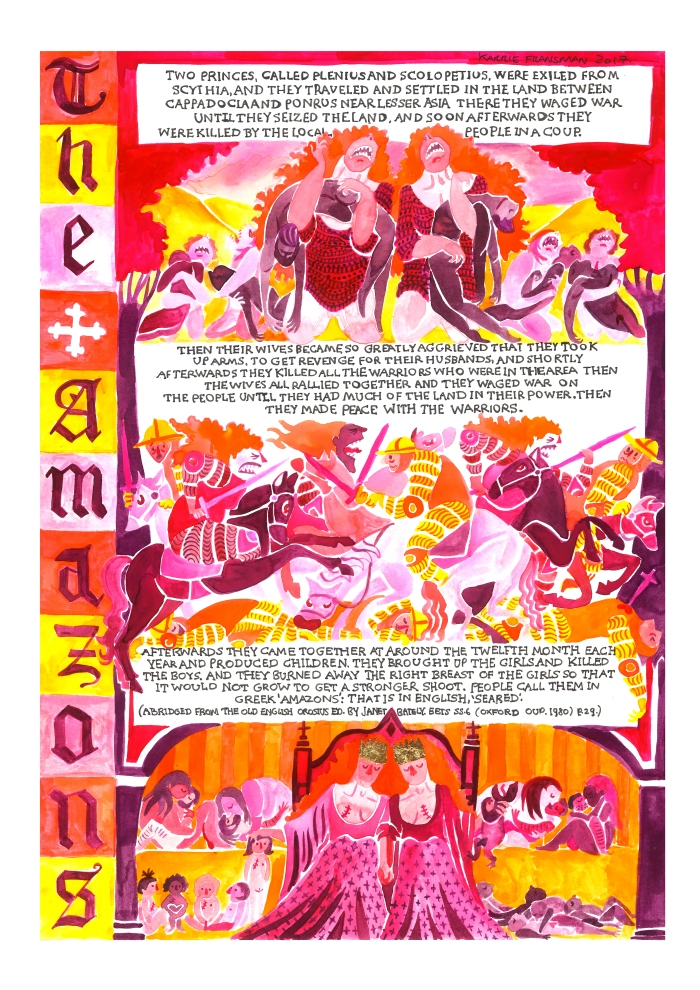
The Amazons © Karrie Fransman 2017 – All Rights Reserved [karriefransman.com]
I do not wish [women] to have power over men but over themselves.
The League of Displaced Women and its City of Women made me think instantly of the Amazons. The legend of the Amazons – an all-female society of warrior women – is all about female power in the face of adversity. The legend of these women, famous for cutting off their breasts, can first be traced back to Ancient Greek mythology (although there is a school of thought that the Amazons did actually exist) and appears in literature from throughout the Anglo-Saxon and medieval period. There are Amazons in The Travels of Sir John Mandeville – a fictional account of a journey to Jerusalem and the East composed in the fourteenth century in French and English. Chaucer’s Canterbury Tales feature the Amazon Hippolyta in The Knight’s Tale. The thirteenth-century Hereford World Map has an image of the Amazon, hand on hip and holding a spear, in the Eastern section of the map.
The origins of the Amazons, and their rise and fall from power, are also recorded in the earliest history of the world in the English vernacular, the Old English Orosius. The Orosius was adapted for an Anglo-Saxon audience in the late ninth/early tenth century from Seven Books of History against the Pagans, a Latin polemic written by Paulus Orosius for a Roman audience in the fifth-century. The Latin text had huge popularity throughout medieval Europe.
In the Orosius account, the Amazons form opportunistically yet organically:
When two Scythian princes are exiled and then killed by the locals in the land in which they settle and take control, their wives are left behind, aggrieved and looking for revenge. They kill the warriors who killed their husbands and the other warriors in the area so that their wives will join them; they become warriors themselves. They wage war and win power over the land. They make peace with the men nearby and come together with them every twelve months for procreative sex. They kill the boys and nurture the girls, burning away their right breasts before they grow to help them shoot arrows. The Amazons are defined by this ritual, which inscribes their cultural identity on their body and into language: ‘[f]or þon hi mon hæt on Crecisc Amazanas, þæt is on Englisc fortende’ (‘because of this they are called Amazanas in Greek, that is in English, seared’). From here, the Amazons’ power grows until they develop a hierarchical social structure with queens who lead armies abroad and defend at home – a strategy that King Alfred the Great was once believed to have adopted when he ruled the West Saxons in the ninth century. They build the city Ephesus and many others and overthrow Europe and most of Asia. They develop an almost cosmological energy: ‘ealle þa worold on hiora agen gewill onwendende wæron folneah c wintra’ (‘the whole world turned on their own will for nearly a hundred years’). It takes Hercules ‘þone ent’ (‘the giant’) to overcome them and to bring the rule of the Amazons to an end, and even he must attack them under the cover of night and with a dromon (a warship) and a thousand men.
[Quotations from the Orosius are taken from The Old English Orosius, ed. by Janet Bately, EETS s.s. 6 (Oxford: Oxford University Press, 1980), Book 1, Chapter 10]
Although their power ends at a worldwide scale, the Amazons have a legacy that is referenced throughout the Orosius and one that pervades the medieval imagination. They represent a parallel, alternative-reality kind of existence as well as an historical one. To the late Anglo-Saxons the Amazons were women (or wifa) but not as they knew them: queens who ruled rather than queens consort, as well as conquerors, warriors, pagans, self-mutilators, from elsewhere. Monsters? Or just different?
Between medieval narratives of the Amazons and the League of Displaced Women stand centuries, not to mention fiction and truth, and very different ethical codes. But both the medieval versions of the Amazonian legend and this twenty-first century organisation provoke us to consider that the way we understand what it means to be human is fluid, and so too therefore are our genders and our social roles. How we perform, structure our societies and use our bodies both define us and break down previously held identities or conventions.
Female power – including that women hold over themselves – and matriarchal, female-led societies are still fascinating concepts and out-of-the-ordinary ideas even now, as they were for the audiences of the Orosius, Chaucer and Mandeville. But in both medieval and modern contexts, imaginary representations or in real-life initiatives, these ideas are possible realities.
This medieval ‘snapshot’ of what it means to be human is one of a series to inspire Karrie Fransman’s medieval comics artwork. To read more, go to project + snapshots.
Dr Victoria Walker recently completed a Ph.D. on the Old English Orosius at King’s College London. She is interested in representations of time and space in Old English literature – especially entanglements between the past, present and future in Anglo-Saxon cosmology – and the narrative function of gender.





Pingback: Karrie’s Medieval Comics | Medieval Comics
Pingback: Medieval Comics workshops at the British Library | Medieval Comics
Pingback: WIP: Mélusine, the Amazons, and Satan’s messenger | Medieval Comics
Pingback: Getting medieval with comics | Medieval Comics